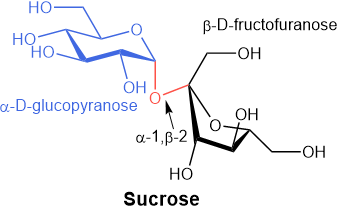5.5: Disaccharides
- Page ID
- 423686
\( \newcommand{\vecs}[1]{\overset { \scriptstyle \rightharpoonup} {\mathbf{#1}} } \)
\( \newcommand{\vecd}[1]{\overset{-\!-\!\rightharpoonup}{\vphantom{a}\smash {#1}}} \)
\( \newcommand{\dsum}{\displaystyle\sum\limits} \)
\( \newcommand{\dint}{\displaystyle\int\limits} \)
\( \newcommand{\dlim}{\displaystyle\lim\limits} \)
\( \newcommand{\id}{\mathrm{id}}\) \( \newcommand{\Span}{\mathrm{span}}\)
( \newcommand{\kernel}{\mathrm{null}\,}\) \( \newcommand{\range}{\mathrm{range}\,}\)
\( \newcommand{\RealPart}{\mathrm{Re}}\) \( \newcommand{\ImaginaryPart}{\mathrm{Im}}\)
\( \newcommand{\Argument}{\mathrm{Arg}}\) \( \newcommand{\norm}[1]{\| #1 \|}\)
\( \newcommand{\inner}[2]{\langle #1, #2 \rangle}\)
\( \newcommand{\Span}{\mathrm{span}}\)
\( \newcommand{\id}{\mathrm{id}}\)
\( \newcommand{\Span}{\mathrm{span}}\)
\( \newcommand{\kernel}{\mathrm{null}\,}\)
\( \newcommand{\range}{\mathrm{range}\,}\)
\( \newcommand{\RealPart}{\mathrm{Re}}\)
\( \newcommand{\ImaginaryPart}{\mathrm{Im}}\)
\( \newcommand{\Argument}{\mathrm{Arg}}\)
\( \newcommand{\norm}[1]{\| #1 \|}\)
\( \newcommand{\inner}[2]{\langle #1, #2 \rangle}\)
\( \newcommand{\Span}{\mathrm{span}}\) \( \newcommand{\AA}{\unicode[.8,0]{x212B}}\)
\( \newcommand{\vectorA}[1]{\vec{#1}} % arrow\)
\( \newcommand{\vectorAt}[1]{\vec{\text{#1}}} % arrow\)
\( \newcommand{\vectorB}[1]{\overset { \scriptstyle \rightharpoonup} {\mathbf{#1}} } \)
\( \newcommand{\vectorC}[1]{\textbf{#1}} \)
\( \newcommand{\vectorD}[1]{\overrightarrow{#1}} \)
\( \newcommand{\vectorDt}[1]{\overrightarrow{\text{#1}}} \)
\( \newcommand{\vectE}[1]{\overset{-\!-\!\rightharpoonup}{\vphantom{a}\smash{\mathbf {#1}}}} \)
\( \newcommand{\vecs}[1]{\overset { \scriptstyle \rightharpoonup} {\mathbf{#1}} } \)
\( \newcommand{\vecd}[1]{\overset{-\!-\!\rightharpoonup}{\vphantom{a}\smash {#1}}} \)
\(\newcommand{\avec}{\mathbf a}\) \(\newcommand{\bvec}{\mathbf b}\) \(\newcommand{\cvec}{\mathbf c}\) \(\newcommand{\dvec}{\mathbf d}\) \(\newcommand{\dtil}{\widetilde{\mathbf d}}\) \(\newcommand{\evec}{\mathbf e}\) \(\newcommand{\fvec}{\mathbf f}\) \(\newcommand{\nvec}{\mathbf n}\) \(\newcommand{\pvec}{\mathbf p}\) \(\newcommand{\qvec}{\mathbf q}\) \(\newcommand{\svec}{\mathbf s}\) \(\newcommand{\tvec}{\mathbf t}\) \(\newcommand{\uvec}{\mathbf u}\) \(\newcommand{\vvec}{\mathbf v}\) \(\newcommand{\wvec}{\mathbf w}\) \(\newcommand{\xvec}{\mathbf x}\) \(\newcommand{\yvec}{\mathbf y}\) \(\newcommand{\zvec}{\mathbf z}\) \(\newcommand{\rvec}{\mathbf r}\) \(\newcommand{\mvec}{\mathbf m}\) \(\newcommand{\zerovec}{\mathbf 0}\) \(\newcommand{\onevec}{\mathbf 1}\) \(\newcommand{\real}{\mathbb R}\) \(\newcommand{\twovec}[2]{\left[\begin{array}{r}#1 \\ #2 \end{array}\right]}\) \(\newcommand{\ctwovec}[2]{\left[\begin{array}{c}#1 \\ #2 \end{array}\right]}\) \(\newcommand{\threevec}[3]{\left[\begin{array}{r}#1 \\ #2 \\ #3 \end{array}\right]}\) \(\newcommand{\cthreevec}[3]{\left[\begin{array}{c}#1 \\ #2 \\ #3 \end{array}\right]}\) \(\newcommand{\fourvec}[4]{\left[\begin{array}{r}#1 \\ #2 \\ #3 \\ #4 \end{array}\right]}\) \(\newcommand{\cfourvec}[4]{\left[\begin{array}{c}#1 \\ #2 \\ #3 \\ #4 \end{array}\right]}\) \(\newcommand{\fivevec}[5]{\left[\begin{array}{r}#1 \\ #2 \\ #3 \\ #4 \\ #5 \\ \end{array}\right]}\) \(\newcommand{\cfivevec}[5]{\left[\begin{array}{c}#1 \\ #2 \\ #3 \\ #4 \\ #5 \\ \end{array}\right]}\) \(\newcommand{\mattwo}[4]{\left[\begin{array}{rr}#1 \amp #2 \\ #3 \amp #4 \\ \end{array}\right]}\) \(\newcommand{\laspan}[1]{\text{Span}\{#1\}}\) \(\newcommand{\bcal}{\cal B}\) \(\newcommand{\ccal}{\cal C}\) \(\newcommand{\scal}{\cal S}\) \(\newcommand{\wcal}{\cal W}\) \(\newcommand{\ecal}{\cal E}\) \(\newcommand{\coords}[2]{\left\{#1\right\}_{#2}}\) \(\newcommand{\gray}[1]{\color{gray}{#1}}\) \(\newcommand{\lgray}[1]{\color{lightgray}{#1}}\) \(\newcommand{\rank}{\operatorname{rank}}\) \(\newcommand{\row}{\text{Row}}\) \(\newcommand{\col}{\text{Col}}\) \(\renewcommand{\row}{\text{Row}}\) \(\newcommand{\nul}{\text{Nul}}\) \(\newcommand{\var}{\text{Var}}\) \(\newcommand{\corr}{\text{corr}}\) \(\newcommand{\len}[1]{\left|#1\right|}\) \(\newcommand{\bbar}{\overline{\bvec}}\) \(\newcommand{\bhat}{\widehat{\bvec}}\) \(\newcommand{\bperp}{\bvec^\perp}\) \(\newcommand{\xhat}{\widehat{\xvec}}\) \(\newcommand{\vhat}{\widehat{\vvec}}\) \(\newcommand{\uhat}{\widehat{\uvec}}\) \(\newcommand{\what}{\widehat{\wvec}}\) \(\newcommand{\Sighat}{\widehat{\Sigma}}\) \(\newcommand{\lt}{<}\) \(\newcommand{\gt}{>}\) \(\newcommand{\amp}{&}\) \(\definecolor{fillinmathshade}{gray}{0.9}\)- Be able to draw and name the glycosidic linkage in disaccharides.
- Know common disaccharides' structures, sources, and properties, including maltose, cellobiose, lactose, and sucrose.
Nomenclature of glycosidic linkage
Disaccharides are glycosides of two monosaccharides. Glycosidic linkage is formed by a reaction between the hemiacetal group of one monosaccharide and an alcohol group of the other, as illustrated in the figure below.

The glycosidic linkage is named by listing the number of the \(\ce{C's}\) linked, separated by a comma. In the case of anomeric carbon, \(\alpha\)/\(\beta\) orientation is also indicated, separated by a hyphen from the number of the anomeric carbon. For example, \(\beta\)-cellobiosee is linked by \(\beta\)-1,4 glycosidic linkage and \(\beta\)-maltose by \(\alpha\)-1,4 glycosidic linkage. The \(\beta\) in the name \(\beta\)-cellobiose and \(\beta\)-maltose indicates the orientation of the free hemiacetal group in the second saccharide unit. It is not related to the orientation of the glycosidic linkage, as indicated by the black arrow in the figure. \(\beta\)-Cellobiose and \(\beta\)-maltose are configurational isomers having different physical and chemical properties.
Examples of disaccharides include maltose, cellobiose, lactose, and sucrose, described next.
Maltose
Maltose is a disaccharide of two D-glucose units connected through \(\alpha\)-1,4-glycosidic linkage, as shown below.

The second D-glucose unit with free hemiacetal group can be either in \(\alpha\)- or \(\beta\)-configuration, as indicated by \(\alpha\)/\(\beta\) prefix to the name. An aqueous solution exists in equilibrium between \(\alpha\), \(\beta\), and open-chain aldose forms. Since common oxidizing agents can reduce the open-chain aldose form, maltose is a reducing sugar. Maltose is found in the juice of sprouted barley grains and other grains.
Cellobiose
Cellobiose is a disaccharide of two D-glucose units connected by \(\beta\)-1,4-glycosidic linkage, as shown below. Hemiacetal forms of cellobiose are shown below.

Cellulobiose is a reducing sugar because, like maltose, the D-glucose unit with free hemiacetal group can exist in \(\alpha\), \(\beta\), or open-chain aldose forms in solution. Cellobiose is obtained by hydrolysis of cellulose.
Lactose
Lactose is a disaccharide of D-galactose joined by \(\beta\)-1,4-glycosidic linkage with D-glucose, as shown below.

Lactose is a reducing sugar because, like maltose, the D-glucose unit with free hemiacetal group can exist in \(\alpha\), \(\beta\), or open-chain aldose forms in solution. Lactose is present in milk, up to 5% to 8% in human milk and 4% to 6% in cow milk. Lactase is the enzyme that hydrolysis lactose in the digestion process. Many adults develop lactose intolerance due to a lack of or insufficient lactase production. Without lactase, lactose enters the colon undigested and is fermented by bacteria causing bloating and abdominal cramps. Therefore, some products that use lactose also add lactase to avoid the problem.
Sucrose
Sucrose is a disaccharide of D-glucose (in pyranose form) and D-fructose (in furanose form) joined by \(\alpha\)-1,\(beta)-2-glycosidic linkage, as shown below.

Both anomeric \(\ce{C,s}\) in the glycosidic linkage can not exist in open-chain aldose or ketose forms. Therefore, sucrose is a non-reducing sugar. Sucrose is commonly used as table sugar. It is the most abundant disaccharide found in sugar cane and sugar beats.
Relative sweetness
Monosaccharides and disaccharides are sweet, but sweetness varies. Fructose is the sweetest monosaccharide, and lactose is the least sweet, as shown in Table 1. Honey is a mixture of fructose and glucose and has a sweetness about the same as table sugar (sucrose). Relative sweetness in the table is based on the results of a group of people tasting and ranking them in order of taste relative to sucrose (table sugar), rated 1. Some artificial sweeteners listed in the table are commonly used as sugar-substitute in diet foods.
| Carbohydrates | Sweetness relative to sucrose | Sugar alcohols | Sweetness relative to sucrose | Artificial sweeteners | Sweetness relative to sucrose |
|---|---|---|---|---|---|
| Fructose | 1.74 | Xylitol | 1.00 | Advantame | 2,000 |
| Sucrose (table sugar) | 1.00 | Maltitol | 0.80 | Saccharin | 450 |
| Honey | 0.97 | Sorbitol | 0.60 | Acesulfame-K | 200 |
| Glucose | 0.74 | Aspartame | 180 | ||
| Maltose | 0.33 | Stevia | 150 | ||
| Galactose | 0.65 | Sucralose | 60 | ||
| Lactose | 0.16 |


